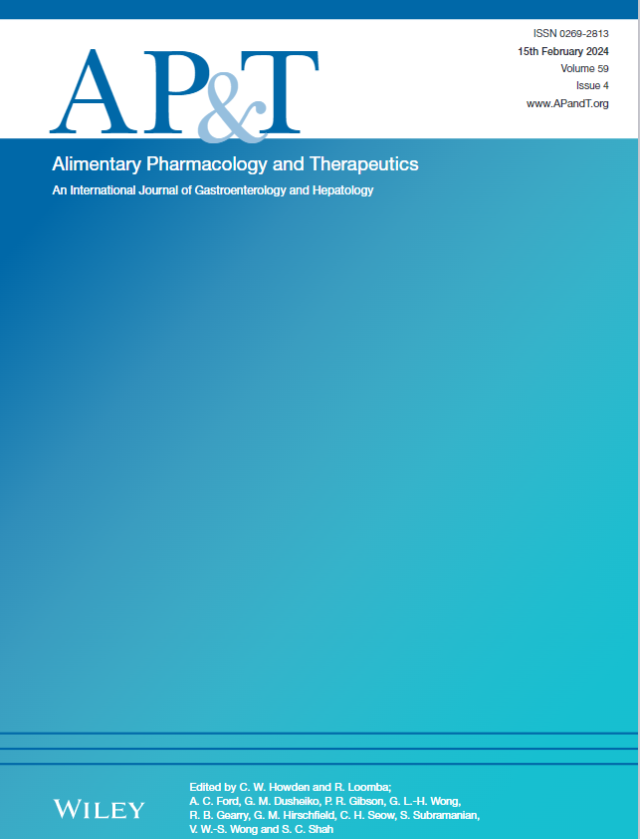Lymphocyte‐to‐Monocyte Ratio as a Predictor of Recompensation in Patients With Decompensated Primary Biliary Cholangitis
IF 6.6
1区 医学
Q1 GASTROENTEROLOGY & HEPATOLOGY
引用次数: 0
Abstract
BackgroundPrimary biliary cholangitis (PBC) patients in the decompensated stage face poor prognoses, with recompensation being crucial for improving long‐term outcomes.AimThis study aims to evaluate the predictive value of the lymphocyte‐to‐monocyte ratio (LMR) for recompensation in decompensated PBC patients.MethodsWe retrospectively analysed 410 patients with PBC‐related decompensated cirrhosis receiving ursodeoxycholic acid (UDCA) treatment. The association between the LMR and recompensation was examined using Cox regression analysis, with additional trend analysis performed based on LMR quartiles. The predictive accuracy of the LMR, neutrophil‐to‐lymphocyte ratio (NLR), systemic immune‐inflammation index (SII) and platelet‐to‐lymphocyte ratio (PLR) was evaluated using receiver operating characteristic (ROC) curve analysis. Sensitivity analyses were conducted to confirm the robustness of the findings.ResultsDuring follow‐up, among 401 patients with decompensated cirrhosis (age: 60.0 [IQR: 53.0–69.0] years; 88.3% female), 105 patients (26.18%) achieved recompensation. Multivariate Cox regression analysis showed that higher LMR was an independent promoting factor for recompensation after adjusting for all confounding factors in the model (HR = 1.415, 95% CI: 1.264–1.585,淋巴细胞-单核细胞比率作为失代偿性原发性胆管炎患者再代偿的预测因子
处于失代偿期的原发性胆管炎(PBC)患者预后较差,再代偿对于改善长期预后至关重要。目的探讨淋巴细胞/单核细胞比值(LMR)对PBC失代偿患者再代偿的预测价值。方法回顾性分析410例接受熊去氧胆酸(UDCA)治疗的PBC相关失代偿性肝硬化患者。使用Cox回归分析检验LMR与再补偿之间的关联,并基于LMR四分位数进行额外的趋势分析。采用受试者工作特征(ROC)曲线分析评估LMR、中性粒细胞与淋巴细胞比值(NLR)、全身免疫炎症指数(SII)和血小板与淋巴细胞比值(PLR)的预测准确性。进行敏感性分析以确认研究结果的稳健性。结果随访期间,401例失代偿期肝硬化患者(年龄:60.0 [IQR: 53.0-69.0]岁;88.3%女性),105例(26.18%)患者获得再补偿。多因素Cox回归分析显示,调整模型中所有混杂因素后,较高的LMR是再补偿的独立促进因素(HR = 1.415, 95% CI: 1.264-1.585, p <;0.001),呈线性正相关趋势。ROC曲线分析显示,与其他炎症标志物(SII, PLR, NLR)相比,LMR具有更优越的预测性能,曲线下面积(AUC)为0.787 (95% CI: 0.736-0.838, p <;0.001)。结论lmr可作为PBC失代偿患者再代偿的独立预测指标。
本文章由计算机程序翻译,如有差异,请以英文原文为准。
求助全文
约1分钟内获得全文
求助全文
来源期刊
CiteScore
15.60
自引率
7.90%
发文量
527
审稿时长
3-6 weeks
期刊介绍:
Alimentary Pharmacology & Therapeutics is a global pharmacology journal focused on the impact of drugs on the human gastrointestinal and hepato-biliary systems. It covers a diverse range of topics, often with immediate clinical relevance to its readership.

 求助内容:
求助内容: 应助结果提醒方式:
应助结果提醒方式:


